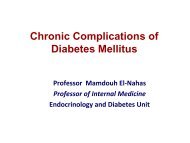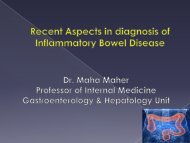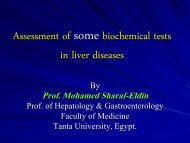Pitfalls in the management of Diabetic Ketoacidosis
Pitfalls in the management of Diabetic Ketoacidosis
Pitfalls in the management of Diabetic Ketoacidosis
You also want an ePaper? Increase the reach of your titles
YUMPU automatically turns print PDFs into web optimized ePapers that Google loves.
Guidel<strong>in</strong>es <strong>in</strong> <strong>the</strong><br />
<strong>management</strong> <strong>of</strong> <strong>Diabetic</strong><br />
<strong>Ketoacidosis</strong><br />
Mamdouh El-Nahas<br />
Pr<strong>of</strong>essor <strong>of</strong> Internal Medic<strong>in</strong>e<br />
Diabetes & Endocr<strong>in</strong>ology unit<br />
Mansoura University
Do we have <strong>in</strong>ternational<br />
Guidl<strong>in</strong>es<br />
• American Diabetes Association (2004)<br />
• British Society <strong>of</strong> Paediatric Endocr<strong>in</strong>ology and<br />
Diabetes (2004)<br />
• International Society for Pediatric and Adolescent<br />
Diabetes (2007)
Treatment <strong>of</strong> DKA could be summarized <strong>in</strong>to fluid, Insul<strong>in</strong> and<br />
K <strong>the</strong>rapy<br />
HOWEVER, DETAILS WILL BE ASSOCIATED<br />
WITH MANY CONTROVERSIAL ISSUES
The 1st pitfall<br />
How to diagnose DKA ?
• Ur<strong>in</strong>e test<strong>in</strong>g for ketone bodies is a simple bedside<br />
test that rapidly confirm diagnosis.<br />
• However, Nitroprusside test measures only<br />
acetoacetate and acetone but not B-hydroxybutric<br />
acid.<br />
• In some patients with DKA B-hydroxybutric acid is<br />
<strong>the</strong> major ketone bodies. Specific tests for B-<br />
hydroxybutric acid are present but not widely used.
Serum betaOHB levels<br />
> 3.0 mmol/l <strong>in</strong> children<br />
> 3.8 mmol/l <strong>in</strong> adults<br />
<strong>in</strong> <strong>the</strong> presence <strong>of</strong> uncontrolled diabetes can be used<br />
to diagnose DKA and may be superior to <strong>the</strong> serum<br />
HCO(3) level for that purpose.<br />
• Diabetes Care. 2008 Apr;31(4):643-7.
The key message (1)<br />
DKA is confidently excluded if serum<br />
beta-hydroxybutyrate is less than 3<br />
mmol/l.<br />
SO we should have meters that measure<br />
B-hydroxybutric acid
The 2nd pitfall<br />
How to start <strong>in</strong>sul<strong>in</strong> <strong>the</strong>rapy?
Large versus small dose regimens<br />
lower doses given at frequent <strong>in</strong>tervals effectively<br />
lower blood glucose and are more safe than<br />
previously adopted regimens.
Load<strong>in</strong>g dose <strong>of</strong> Insul<strong>in</strong><br />
Us<strong>in</strong>g load<strong>in</strong>g dose <strong>of</strong> <strong>in</strong>sul<strong>in</strong> also makes no<br />
difference because <strong>the</strong> <strong>in</strong>itial blood glucose<br />
response is largely dependent on rehydration.
Still recent debate<br />
• To assess <strong>the</strong> efficacy <strong>of</strong> an <strong>in</strong>sul<strong>in</strong> prim<strong>in</strong>g dose with a<br />
cont<strong>in</strong>uous <strong>in</strong>sul<strong>in</strong> <strong>in</strong>fusion versus two cont<strong>in</strong>uous doses<br />
without prim<strong>in</strong>g (0.07 & 0.14U U/kg/h)<br />
• prim<strong>in</strong>g dose <strong>in</strong> low-dose <strong>in</strong>sul<strong>in</strong> <strong>the</strong>rapy <strong>in</strong> DKA patients is<br />
unnecessary if us<strong>in</strong>g an adequate dose <strong>of</strong> 0.14U <strong>of</strong> regular<br />
<strong>in</strong>sul<strong>in</strong> per kg/Bwt/h (about 10U/h <strong>in</strong> a 70kg patient).<br />
• Kitachi et al: Is A Prim<strong>in</strong>g Dose Of Insul<strong>in</strong> Necessary In A Low<br />
Dose Insul<strong>in</strong> Protocol For The Treatment Of <strong>Diabetic</strong><br />
<strong>Ketoacidosis</strong>?. Diabetes Care. 2008 Aug 11
The key message (2)<br />
• Insul<strong>in</strong> <strong>the</strong>rapy should be started with low<br />
doses at frequent <strong>in</strong>tervals (0.1 unit / kg/ hr)<br />
regular <strong>in</strong>sul<strong>in</strong> by IV <strong>in</strong>fusion or IM <strong>in</strong>jection<br />
• But <strong>the</strong> response to <strong>in</strong>sul<strong>in</strong> should be<br />
monitored. The predicted response to <strong>in</strong>sul<strong>in</strong> is<br />
10% reduction from its <strong>in</strong>itial level (about 75 mg<br />
drop <strong>in</strong> blood glucose) every hour. If this is not<br />
achieved after 2 hr <strong>of</strong> <strong>the</strong>rapy double <strong>the</strong> dose<br />
<strong>of</strong> <strong>in</strong>sul<strong>in</strong> .
The 3th pitfall<br />
Do we need rapid vigorous correction <strong>of</strong><br />
dehydration?
Fluid <strong>the</strong>rapy<br />
• Type <strong>of</strong> fluid needed (Quality)<br />
• Amount <strong>of</strong> fluid needed ( Quantity)<br />
• The rate <strong>of</strong> <strong>in</strong>fusion
Amount <strong>of</strong> fluid needed (Quantity)<br />
Ma<strong>in</strong>tenance fluid + fluid deficit<br />
Ma<strong>in</strong>tenance fluid (1500 ml/m2 /24hr)<br />
+<br />
Fluid deficit<br />
(Fluid deficit <strong>in</strong> patients > 2yrs )<br />
=<br />
30ml/ kg for mild deficit<br />
60ml/kg for moderate deficit<br />
90ml/kg for severe deficit
The rate <strong>of</strong> <strong>in</strong>fusion<br />
• Fluid resuscitation by 10-20 ml /kg <strong>in</strong> <strong>the</strong> first hour.<br />
In severe dehydration this dose may be repeated but<br />
<strong>the</strong> <strong>in</strong>itial re- expansion should not exceed 50 ml/kg<br />
over <strong>the</strong> first 4 hr <strong>of</strong> <strong>the</strong>rapy.<br />
• Then give <strong>the</strong> rema<strong>in</strong><strong>in</strong>g total volume evenly over<br />
<strong>the</strong> next 48 hours .
The key message (3)<br />
• Start fluid <strong>the</strong>rapy with 10-20 ml /kg isotonic sal<strong>in</strong>e <strong>in</strong><br />
<strong>the</strong> first hour. In severe dehydration this dose may be<br />
repeated but <strong>the</strong> <strong>in</strong>itial re- expansion should not exceed<br />
50 ml/kg over <strong>the</strong> first 4 hr <strong>of</strong> <strong>the</strong>rapy.<br />
• Use glucose 5% <strong>in</strong>stead <strong>of</strong> sal<strong>in</strong>e if BG dropped below<br />
250mg%
The 4th pitfall<br />
Potassium assessment and replacement
Potassium Assessment<br />
• Assessment <strong>of</strong> K status is an important item <strong>in</strong> <strong>the</strong><br />
<strong>management</strong> <strong>of</strong> DKA.<br />
• If you didn’t have reliable lab. ECG can give some<br />
h<strong>in</strong>t about s K.
Potassium replacement<br />
(In <strong>the</strong> absence <strong>of</strong> reliable lab)<br />
Give 20 mEq K/hr<br />
Stop K <strong>in</strong>fusion:<br />
‣ If <strong>the</strong> patient is anuric<br />
‣ If ECG revealed tall T wave
Potassium replacement<br />
(In <strong>the</strong> presence <strong>of</strong> reliable lab)<br />
‣ If serum K is < 2.5 mEq/L give 60mEq K/ liter <strong>of</strong> fluids<br />
and stop <strong>in</strong>sul<strong>in</strong> temporarily.<br />
‣ If serum K is 3 mmol/L<br />
give 40 mEq K /hr<br />
‣ If serum K is 3 -4 mmol/L give 30 mEq<br />
K/hr
The key message (4)<br />
Even if you didn’t have reliable lab you should<br />
give K by small dose 20 mEq K/hr and follow T<br />
wave changes.
The 5th pitfall<br />
Cerebral oedema as a complication <strong>of</strong><br />
DKA treatment
• Cerebral oedema is a fatal complication <strong>of</strong> treatment<br />
<strong>of</strong> DKA, It accounts for 40 % <strong>of</strong> DKA deaths.<br />
• Rapid decl<strong>in</strong>e <strong>in</strong> plasma osmolality as a result <strong>of</strong><br />
rapid decl<strong>in</strong>e <strong>of</strong> blood glucose or excessive <strong>in</strong>fusion<br />
<strong>of</strong> hypotonic sal<strong>in</strong>e will lead to cerebral oedema.<br />
• The pathogenesis appears complex and is poorly<br />
understood. Dehydration and hypocapnia dim<strong>in</strong>ish<br />
cerebral perfusion, result<strong>in</strong>g <strong>in</strong> mild bra<strong>in</strong> ischaemia<br />
and subsequent cytotoxic and vasogenic cerebral<br />
oedema.
Diagnosis <strong>of</strong> cerebral oedema<br />
• Cerebral oedema should be suspected if<br />
consciousness start to be disturbed while metabolic<br />
status is improv<strong>in</strong>g.<br />
• Bra<strong>in</strong> stem herniation may be rapid so that<br />
papilledema is not found.<br />
• About 40% <strong>of</strong> cases showed no acute abnormalities<br />
on <strong>the</strong>ir <strong>in</strong>itial CT exams, emphasiz<strong>in</strong>g that CE <strong>in</strong> <strong>the</strong><br />
context <strong>of</strong> DKA is a cl<strong>in</strong>ical, not a radiological,<br />
diagnosis.
Neurological Deterioration <strong>in</strong> <strong>Diabetic</strong><br />
<strong>Ketoacidosis</strong> – Is it Cerebral Edema or<br />
Someth<strong>in</strong>g Else?
Cerebral edema is <strong>the</strong> most likely cause <strong>of</strong> acute<br />
neurological deterioration <strong>in</strong> DKA, though <strong>in</strong> about<br />
20% <strong>of</strong> acute neurological episodes o<strong>the</strong>r causes<br />
should be suspected e.g.<br />
‣ Cerebral venous thrombosis<br />
‣ Viral encephalitis<br />
‣ Men<strong>in</strong>gitis (TB, streptococcal, men<strong>in</strong>gococcal)
Treatment <strong>of</strong> CE<br />
• The current treatment for suspected CE is immediate<br />
<strong>in</strong>fusion <strong>of</strong> mannitol 0.5-1 g/kg over 20 m<strong>in</strong>utes and<br />
to restrict fluids.<br />
• Endotracheal <strong>in</strong>tubation may be needed to protect<br />
<strong>the</strong> airway <strong>of</strong> <strong>the</strong> comatose patient, but <strong>the</strong> value <strong>of</strong><br />
hyperventilation is questionable.
The key message (5)<br />
Early diagnosis and treatment <strong>of</strong> CE will<br />
markedly reduce mortality <strong>in</strong> DKA
The 6th pitfall<br />
Do we need a follow up sheet for DKA?
The key message (6)<br />
Patient with DKA should be carefully monitored<br />
to ensure adequate response to <strong>the</strong>rapy and to<br />
early diagnose CE
The 7th pitfall<br />
When <strong>Diabetic</strong> Keto acidosis is<br />
considered resolved ?
1hr 6hr 12hr 18hr<br />
acidosis<br />
ketones<br />
Glucose
The key message (7)<br />
DKA is considered resolved when 2 <strong>of</strong> <strong>the</strong> follow<strong>in</strong>g criteria were met:<br />
1. HCO3 > 18 mEq/L<br />
2. Venous pH > 7.32 (venous pH is 0.03 U lower than arterial pH)<br />
3. Calculated anion gap less than 14 mEq/L.
For one mistake done <strong>in</strong> not<br />
know<strong>in</strong>g, ten mistakes are done<br />
<strong>in</strong> not do<strong>in</strong>g
Thank you









